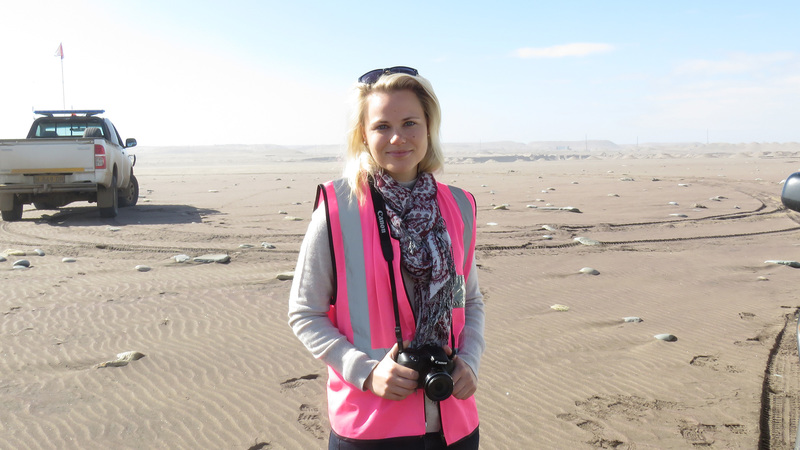Desert research leads to master’s degree
08 December 2020 | Story Farah Khalfe. Photo Liezl Maritz. Video editors Nico Badenhuizen, Evan Zerf. Read time 6 min.“During my solo fishing expeditions, there would always be black-backed jackals nearby, indifferent to my presence, observing and patiently waiting for me to finish my dissections so they [could] collect fish scraps. Regular sightings of the peculiar brown hyena were a constant reminder of the wild nature of the coast. This experience has taught me to make time to reflect and appreciate the small moments in life.”
This is how University of Cape Town (UCT) graduate Liezl Maritz describes the experience of completing her Master’s in Biological Sciences while working in isolation on the coast of the southern Namib desert.
After completing a degree in environmental management in 2012, and then obtaining a BSc Honours in Geography – both from UNISA – Liezl was well equipped to identify and understand spatio-temporal patterning and the relationship between natural and anthropogenically induced phenomena.
The study
In 2017 she put these skills to use when she began her master’s. Her research took place within the Southern Coastal Mines licence area — one of the largest licencing areas held by Namdeb Diamond Corporation, where Liezl has been employed since 2012. The region is a high-security area enclosed by a double fence where public access is strictly controlled.
She undertook the first (and only) investigation of the ecological viability of wetland marine ponds created by diamond-mining activities.
“The mining activity that takes place progressively pushes the coastline out into sea. This enables mining to take place in what was previously a surf zone, in the lee of ‘sea walls’ that hold the sea at bay. In the process, multiple large marine ponds – some as much as 1 km long – are created along the coast, which are clearly visible on Google Earth,” she said.
“Liezl aimed to assess whether these ponds could supplement the sparse estuarine and lagoonal systems that exist on the parched coast.”
Prior to the mining, the coast was covered in a naturally occurring dune hammock system, which has now disappeared and been replaced by the man-made marine ponds. Liezl aimed to assess whether these ponds could supplement the sparse estuarine and lagoonal systems that exist on the parched coast.
When conducting her study, which took place on an area approximately 75 km in length and with 150 pools in total, she assessed the age, physical properties, amount of salt-marsh vegetation, bird species and fish benefitting from each pond. This allowed her to determine whether the ponds serve an important ecological role worth preserving.
In the end, the final verdict was positive. Her research revealed that the pools do in fact support and attract biodiversity.
“In short, they allow the development of salt marshes that would otherwise be absent, support populations of a limited number of marine fish species and have a remarkably rich waterbird fauna.”
Findings from her research show that the rich waterbird fauna found in the area is on par with other regions classified as Important Bird and Biodiversity Areas. Thirty-six different bird species were recorded during her study, and the ponds provide an attractive alternative habitat for waterbirds to nest, forage and roost.
Silver lining
With these findings, as well as her ongoing research, Liezl is confident that she will make a valuable contribution to the biodiversity conservation efforts in the Southern Coastal Mines area and Namibia as a whole, as well as create opportunity for the fields of restoration, ecology and mining environmental management to expand and grow.
“There are a limited number of studies conducted in the area because of access restrictions, making the data I collect very valuable,” she added.
Access control wasn’t the only challenge she faced when completing her degree, however. She also had a full-time job and had to constantly balance her time, energy and attention. She overcame this obstacle by strictly managing her daily schedule and weekly deliverables. Allowing time for herself to rest and recuperate was also an important factor in her success.
“My conservation project is a continuation of my MSc project — with a focus on multiple bird species.”
With only a two-way radio to communicate with security in the study area, and having remote contact with her supervisors, Liezl admitted that despite all the challenging times there were also many rewarding moments, which is “typical when spending time in nature”.
She also recently completed a training programme for conservation leadership, administered by Fauna and Flora International and funded by De Beers. Moving forward, she plans to continue working on her conservation project for this programme.
“My conservation project is a continuation of my MSc project — with a focus on multiple bird species and explores the extent to which birds benefit from the existence of the mining ponds,” she explained.
Up and away
For Liezl, it was always a pleasure sharing her experiences with her supervisors, Professor George Branch and Dr Deena Pillay, who have visited and share the same passion for the unique area.
When it comes to motivational forces during her study, she credits Professor Branch for playing a critical role in her success.
“He is regarded as a world leader in the field of marine science and sets an admirable example of what one can achieve through hard work and dedication. His guidance, support and kindheartedness are what kept me motivated.”
It is evident that for Liezl this degree is more than just an accolade. Instead, it is a symbol of the lasting positive impact and legacy she is leaving in her field and beyond.
 This work is licensed under a Creative Commons Attribution-NoDerivatives 4.0 International License.
This work is licensed under a Creative Commons Attribution-NoDerivatives 4.0 International License.
Please view the republishing articles page for more information.











